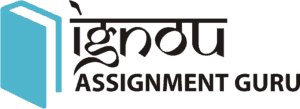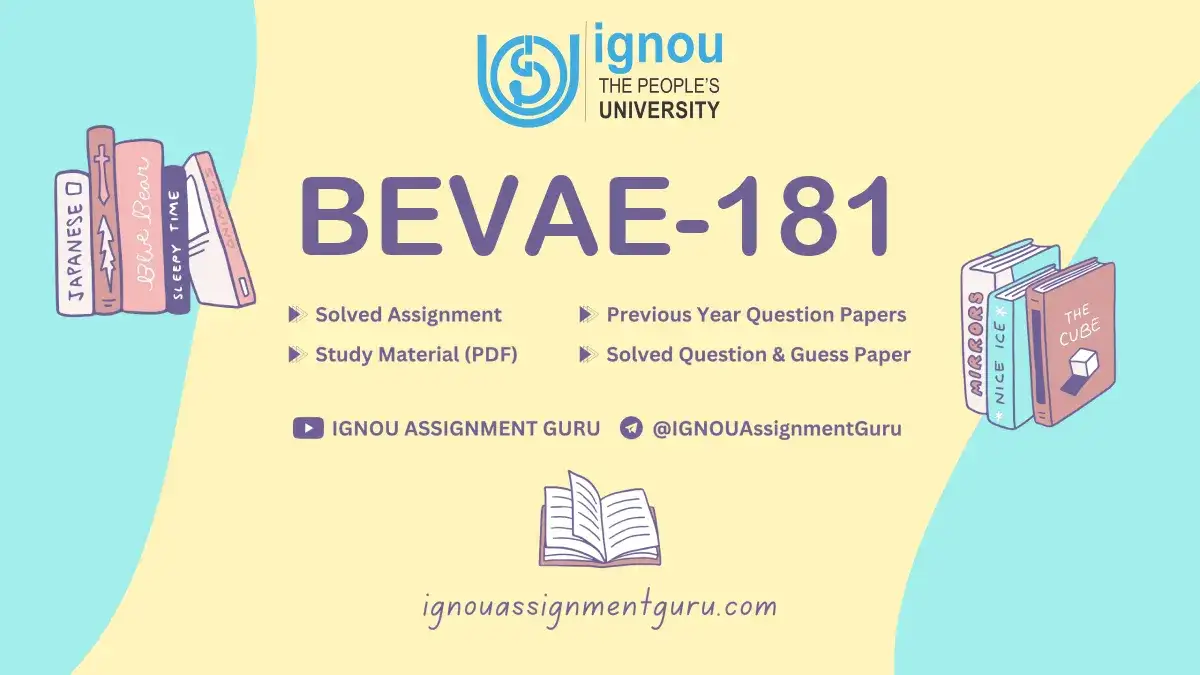BEVAE-181 AECC ON ENVIRONMENTAL STUDIES in English Solved Question Paper December 2023
AECC ON ENVIRONMENTAL STUDIES
Course Code: BEVAE-181
| Title Name |
BEVAE-181 Solved Question Paper December 2023 |
| University | IGNOU |
| Service Type | Solved Question Paper (Soft copy/PDF) |
| Course | BAG |
| Language | English |
| Year | December 2023 |
| Course Code | BEVAE-181 |
| Product | Solved Question Paper (IGNOU) |
1. The concept of Sustainable Development was formally defined
in :
(1) Brundtland Commission Report
(2) Delor Commission Report
(3) Swaminathan Commission Report
(4) Maurice Strong Commission Report
2. Moving from pollution intensive economic production to environment
friendly processes :
(1) Environmental Transition (2) Technological Transition
(3) Industrial Transition (4) Economic Transition
3. Which one of the following is not one of the Sustainable Development
Goals (SDGs) ?
(1) Clean water and sanitation
(2) Affordable and clean energy
(3) Clean air
(4) Life on land
4. Decomposers are otherwise known as :
(1) Autotrophs (2) Heterotrophs
(3) Phagotrophs (4) Saprotrophs
5. Which one of the following statements related to ecosystem is false ?
(1) All ecosystems have well defined boundaries.
(2) Ecosystem represents enormous contrast in size and complexity.
(3) Ecosystem is a unit of study.
(4) The term ecosystem was coined by Tansley.
6. Water component of biosphere is known as :
(1) Lithosphere (2) Atmosphere
(3) Hydrosphere (4) Biosphere
7. In which of the following trophic level quaternary consumers are
found ?
(1) Trophic level-I (2) Trophic level-III
(3) Trophic level-IV (4) Trophic level-V
8. In which type of forest hemlock, yew and maple trees are found ?
(1) Temperate rain forest
(2) Temperate evergreen forest
(3) Temperate deciduous forest
(4) Coniferous forest
9. Which one of the following is a predator of desert locust ?
(1) Calotes
(2) White rumped vultures
(3) White scaventure vultures
(4) Loricata
10. Organism found living at the bottom of the water mass is known as :
(1) Nekton (2) Plankton
(3) Neuston (4) Benthic
11. Which of the following oceanic zone is rich in species and high in
productivity ?
(1) Littoral zone (2) Pelagic zone
(3) Neritic zone (4) Benthic zone
12. Which of the following is a non-renewable resource ?
(1) Forest (2) Water
(3) Pastures (4) Minerals
13. The total salt content in fresh water is :
(1) Below 3% (2) Below 1.5%
(3) Below 2% (4) Below 2.5%
14. Which of the following soils is best suited for cotton ?
(1) Red soil (2) Black soil
(3) Laterite soil (4) Alluvial soil
15. Which one of the following is not a soil conservation method ?
(1) Construction of checkdams
(2) Planting of trees
(3) Keeping the soil wet
(4) Formation of broad wall along the coast
16. Which one of the following is an economic significance of forests ?
(1) Supporting natural ecological systems and processes
(2) Moderation of global climate
(3) Protection of biodiversity
(4) Deriving products to be used as insecticides and pesticides
17. Which of the following statements related to forest is not correct ?
(1) It is a major source of carbon sink.
(2) It prevents landslides.
(3) It is directly responsible for vector-borne diseases.
(4) It is the greatest repository of biodiversity.
18. Deforestation leads to :
(1) increased soil erosion
(2) reduction in the carbon dioxide liberated by plants
(3) increases in the water table
(4) decrease in pollution
19. Which one of the following species is highest in number in the
biodiversity ?
(1) Plant (2) Animal
(3) Fish (4) Insects and micro-organisms
20. Which of the following biogeographic zone covers the largest area in
India ?
(1) The coasts (2) The Western Ghats
(3) The Deccan peninsula (4) The Gangetic plain
21. Which of the following is a biological hotspot in India ?
(1) The Eastern Ghats
(2) The Western Ghats
(3) The Sunderbans in West Bengal
(4) Bhitar Kanika in Odisha
22. Which one of the following is not an indirect use value of biodiversity ?
(1) Aesthetic value (2) Bequest value
(3) Non-consumptive value (4) Cultural and religious value
23. Which one of the following is not a non-conventional source of energy ?
(1) Atomic energy (2) Solar energy
(3) Wind energy (4) Geothermal energy
24. Which of the following areas in India is considered to be suitable for
geothermal energy ?
(1) The North-Western Himalaya
(2) The North-Eastern Himalaya
(3) The Western Rajasthan
(4) The East Coast of India
25. More than half of the energy need of India is met by :
(1) Oil (2) Coal
(3) Hydropower (4) Natural gas
26. Urjagram refers to :
(1) Villages which produce their own required energy resources.
(2) Villages in which non-conventional alternative system has been
installed by government on experimental basis.
(3) Model villages were established to create awareness about
judicious use of energy resources.
(4) It is not related to energy resources.
27. Which of the following is an example of selective destruction ?
(1) Sea gulls (2) Cheetah
(3) Passenger pigeons (4) Crocodiles
28. Which one of the following animals is not a part of commerical hunting ?
(1) Whale (2) Deer
(3) Snake (4) Wild Ass
29. Which of the following is not an example of invasive species ?
(1) Water hyacinth (2) Congress weed
(3) Sweet pea (4) Mesquite
30. Which of the following is an example of in-situ conservation ?
(1) National parks (2) Zoological parks
(3) Captive breeding (4) Fostering
31. Which of the following is a non-point source pollutant ?
(1) Discharge of effluents through chimneys
(2) Discharge through pipes from industries
(3) Run-offs from agricultural fields
(4) Dumping of toxins in a confined area
32. Which of the following is not a primary pollutant ?
(1) Carbon monoxide (2) Carbon dioxide
(3) Sulphur dioxide (4) Sulphuric acid
33. Standard level of RSPM in India is :
(1) 50 microgram per cubic metre
(2) 60 microgram per cubic metre
(3) 40 microgram per cubic metre
(4) 30 microgram per cubic metre
34. Coliform can be detected by conducting :
(1) MPN test (2) TDS test
(3) BOD test (4) COD test
35. Which one of the following is not a waste minimisation method ?
(1) Process modification (2) Waste segregation
(3) Recycling of waste (4) Waste concentration
36. Which of the following is a biological treatment method of waste ?
(1) Incineration (2) Solidification
(3) Digestion (4) Solution
37. The best way to dispose nuclear waste is :
(1) Incineration (2) Underground disposal
(3) Dumping at sea (4) Landfill disposal
38. Which of the following is not a Green House Gas ?
(1) Carbon dioxide (2) Methane
(3) Sulphur dioxide (4) Chlorofluorocarbon
39. Which one of the following is not one of the eight missions of National
Action Plan on climate change ?
(1) National water mission
(2) National mission for green India
(3) National mission for sustainable agriculture
(4) National rural health mission
40. Ozone layer in the atmosphere is generally found in :
(1) Upper layer of the stratosphere
(2) Upper layer of the troposphere
(3) Upper layer of the mesosphere
(4) Upper layer of the ionosphere
41. The principal bench of National Green Tribunal is located at :
(1) New Delhi (2) Mumbai
(3) Kolkata (4) Chennai
42. Montreal Protocol on Substances that deplete the ozone layer was
agreed by nations in :
(1) 1985 (2) 1987
(3) 1989 (4) 1991
43. The Basel Convention is related to :
(1) Bodiversity
(2) Ozone layer depletion
(3) Chemicals and hazardous wastes
(4) Climate change
44. Which of the following diseases is not due to genetic influence ?
(1) Haemophilia (2) Sickle cell anaemia
(3) Down’s syndrome (4) Schizophrenia
45. Match the following and find out the correct alternatives given below :
Category Name of the hazard
(a) Atmospheric (i) Forest fire
(b) Biological (ii) Drought
(c) Geological (iii) Heat wave
(d) Hydrological (iv) Landslides
Codes :
(1) a-ii, b-i, c-iv, d-iii (2) a-iii, b-i, c-iv, d-ii
(3) a-i, b-ii, c-iii, d-iv (4) a-iv, b-iii, c-ii, d-i
46. Which of the following region falls under high seismic zones in India ?
(1) Coastal Odisha (2) Rann of Kachchh
(3) Eastern Rajasthan (4) Bundelkhand
47. What could be the population of the world by 2100 ?
(1) 11.2 billion (2) 11.8 billion
(3) 13.2 billion (4) 13.8 billion
48. Which of the following is not an ENVIS centre ?
(1) National Institute of Occupational Health (NIOH), Ahmedabad
(2) Centre for Theoretical Studies (CTS) Indian Institute of Science,
Bengaluru
(3) All India Institute of Medical Sciences, New Delhi
(4) Industrial Toxicology Research Centre (ITCR), Lucknow
49. Which one of the following view towards the nature believes that all
organisms on the Earth have values and rights ?
(1) Anthropocentrism (2) Ecocentrism
(3) Ecofeminism (4) Stewardship
50. Using English material to communicate to non-English speaking
communities is an example of :
(1) Procedural inequity (2) Geographical inequity
(3) Social inequity (4) Economic inequity
FAQs
How can solving previous year question papers improve my exam performance?
Solving previous year question papers helps you become familiar with the exam format, identify important topics, and develop effective time management and problem-solving skills, leading to improved performance.
Can I solely rely on previous year question papers for exam preparation?
While previous year question papers are an essential part of exam preparation, it is advisable to supplement them with comprehensive study materials, textbooks, and practice tests for a well-rounded approach.
Can solving previous year question papers guarantee a good score?
Solving previous year question papers enhances your preparation and boosts confidence, but the final score depends on various factors, including consistent studying, understanding concepts, and effective exam strategy.




